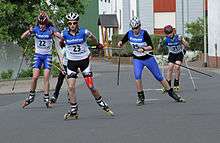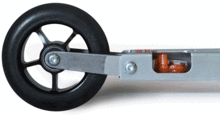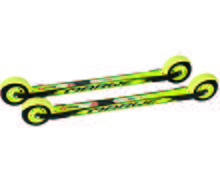Roller skiing

Roller skiing is an off-snow equivalent to cross-country skiing. Roller skis have wheels on their ends and are used on tarmac to emulate cross-country skiing.[1][2] The skiing techniques used are very similar to techniques used in cross-country skiing on snow.
First created as a summer training exercise, roller skiing has now grown into a competitive sport in its own right. Annual championships are held in various locations around the world.[3] Most, if not all, national cross-country ski teams around the world roller ski during the off-season for specific physical training simulating winter skiing. In Norway, separate roller ski facilities have been constructed to allow exercise off public roads.[4]
History
The first roller skis were built in the mid-1930s in Italy and North Europe.
In the early 1950s, when cross-country skiing started to evolve to a serious competition sport, the necessity for good summer training grew. All around the world from 1950s to 1970s people experimented with skis on wheels.
In the 1970s, something of a standard emerged and the first races took place. At this time all roller skis had one wheel in front and two wheels at the back. The metal frame was between 70 and 100 centimetres (2'4" and 3'4") long.
Athletes felt they could start to engage themselves in competitions. In 1976, Giustino Del Vecchio, an air pilot, established a record in Monza by doing 240.5 km in 24 hours thanks to the roller skis he had designed, using material and technologies from the aircraft industry; narrow solid wheels with hard tread, reverse lock-up ball bearings to enable push forward.[5]
In 1987, Mark Richardson (b.25 May 1962) roller skied From Chamonix, France to Canterbury, England from 6–21 May, a distance of approximately 1000 km (621 miles) unsupported. See 1989 Guinness book of World Records 1989 page 279.
In the beginning, the skis were developed with one wheel in front and two wheels behind. The introduction of skating (free technique) in cross-country skiing changed athletes' training needs, which consequently impacted the design of roller skis. New roller skis with two wheels instead of three and much lighter materials could be used both for the classic style and skating. Paolo Miorin, who designed the Skirollo, may have been the inventor of two-wheeled roller skis.
The World Record for the greatest number of roller skiers in one place was established in the Gatineau Park, Chelsea Quebec, Canada 2 October 2010.
Competition


The European Rollerski Federation was established around 1985, and the first European Championships were organized in the Netherlands in 1988.
The growth of the roller ski sport attracted the notice of the International Ski Federation, or FIS (Federation Internationale de Ski). In 1992, the FIS recognized roller skiing as a sport distinct from cross-country skiing.
The first World Games were held in The Hague in 1993, and the first World Cup roller ski races later in the same year. In 1998, in Prague, the FIS granted roller skiing an official FIS World Championships. On 30 August- 3 September 2000, these competitions took place in the Netherlands.
Races have a variety of formats with different terrain. Formats include relays, sprints, team races, individual races and pursuit races. Terrain varies from relatively flat to hilly. On flat courses the speed can be as fast as 50 kilometres per hour (30 miles per hour). Average speed on flat tracks in World Cup races can easily be 30 kilometres per hour (20 miles per hour). As in regular cross-country skiing, the skiers compete in classic and free style. Helmets and protective eyeglasses in competitions are mandatory.
World Cup and World Championships
The Italian, Russian, Norwegian, Swedish, German and French rollers have been very strong in competitions compared to other nations since the beginning of competitive roller skiing. Note that World Roller Skiing championships are not an officially sanctioned races by FIS or recognized sports governing bodies.
Men
So far, the World Cup and World Championships, have been dominated by a few skiers. Successful roller skiers include Italian Alfio di Gregorio, who has won the World Games three times and World Cup four times; Russian Igor Glushkov, who has won the World Cup three times; and Frenchman Vincent Vittoz, who won the World Championships in 2002.
Women
Mateja Bogatec from Italy has been one of the most successful female rollers since the beginning of the FIS World Cup in 2000.
Equipment
Roller skis for classic and skate style skiing are used, as well as "combi" skis which may be used for either technique. Off-road roller skis are a variation designed for rougher surface conditions.
Classic style roller skis usually have wider wheels to provide better balance and classic technique simulation. Diameter is often smaller 75 mm to keep weight reasonable unless if pneumatic. A ratchet or ratchet-like mechanism in one of the wheels on each ski allows for uni-directional travel to simulate "grip" — comparable to grip wax on snow; the other wheel is free-rolling.
Skate roller skis usually have narrower wheels around 24 mm wide (similar to those used on inline skates) to allow easier skating. Diameter is usually 100 or 105 mm unless if pneumatic. Both wheels on the ski are free-rolling, with no ratchet mechanism.
The shafts of the skis may be composed of many different materials depending on the manufacturer and model. Wood was originally used, though this has mostly been replaced by aluminum, fiberglass, kevlar, carbon fiber or a combination of these materials. The length of the shaft is typically shorter for the skate roller skis than the classic roller skis. The longer shaft for the classic roller skis help provide a better simulation of snow skiing. Many manufacturers sell junior roller skis, with shorter shafts to reduce the overall weight for younger skiers. Longer shaft provides straighter tracking, and a more balanced ski when bindings properly mounted as close to balance point as possible, but never behind balance point.
Forks which hold the wheels to the shaft are either built into the shaft as one consistent piece of material as many aluminum straight frames are, or bolted to the shaft. Most composite rollerski frames made of fibreglass or carbon fiber have forks bolted on made of aluminum usually. In 2015 Pursuit Rollerskis released a new design using spring steel for the forks utilizing the springy properties of spring steel most commonly used in springs which handles fatigue stress better than other metals.


Rollerski flex ranges from rigid to soft. Flex makes for a smoother ride. Composite frames can provide a very soft feel with the most flex in the center creating a concave flex. In 2003 Rune Dønnestad of Dynasports invented the first modern mechanical flexing roller ski using pivoting forks with metal springs. A pivoting forks design is also used by Rundle Sport FLEX roller skis, with the exception that Rundle Sport uses rubber dampers instead of metal springs to reduce vibration. Both Dynasports and Rundle Sport designs utilize a flatter flex, and 2 companies that have taken out the pivoting but also achieve a degree of flatter flex are Quionne using carbon fiber with flex zones by the forks, and Pursuit utilizing spring steel forks.
There are also types of roller skis that have 3 wheels, with one on the front and two on the back. These are less common more recently due to extra weight on rear created tail drop. Benefits back in the day were stability mostly.
Roller skis with pneumatic tires (such as skikes) are also available for rough pavement and off-road use.
Normal cross-country ski bindings and ski boots can be used with most roller skis, though some manufacturers produce special roller ski versions for the warmer weather use including Alpina, Botas, and Fischer. Cross-country ski poles are also used, with the basket replaced by a ferrule, essentially a reinforced carbide steel spike molded into strong plastic.
Extra protective clothing is recommended: full-finger gloves, helmet, eye wear, and knee and elbow pads. Many ski training programs require the use of helmets while roller skiing.
In 2015, the revolutionary rollerski with disc-brakes controlled remotely from your pole from RollerSafe.no were released. The patent was first penned by Atle Stubberud and first showed in a student work on an off-road Rollerskate (1999). SoonDesign.no Most roller skis don't have bona fide brakes, except for a calf-activated brake pioneered by Len Johnson of V2 Jenex with other companies now making similar version, or the rear pull brake designed by Clayton Keim of Pursuit Rollerskis. Speed reducers, available on some models, work by providing different levels of friction against the wheels. Different types of wheels are also available that are slower thus limiting maximum speed. Techniques for slowing down without the use of speed reducers or brakes including dragging the pole ferrules, "snowplowing" where you do a wide stance applying outward pressure on back wheels, or the inline skater "in-step" method.
Popular manufacturers of roller skis are: Briko-Maplus (Italy), Eagle Sport (The Netherlands), Elpex (Sweden), Fischer (Austria), Marwe (Finland), Oneway (Finland), Pro Ski (Sweden), Pursuit (US), Quionne (Spain), RollerSafe.no (Norway), Rundle Sport (Canada), Skigo (Sweden), SkiSkett (Italy), Start (Finland), Swenor (Norway), and V2 Jenex (US).
Roller skiing is most popular in Europe particularly France, Italy, Norway, Finland, Estonia, Sweden, and Russia, where there are many serious races and even a World Cup Circuit. In North America, roller skiing is popular in areas with many Nordic skiers such as Ontario, Alberta, Alaska, New York, Vermont, New Hampshire, Maine, Minnesota, and Wisconsin.
Nordic blading
Nordic blading is a sport which uses ski poles with special tips and inline skates or roller skis. The sport has been practiced for over 80 years and is undergoing a revival. The benefits of Nordic blading are similar to that of cross-country skiing if performed correctly. Nordic blading can be more risky than inline skating as the poles complicate balance and coordination.
Types of techniques used

- One-skate (V1)
- Two-skate (V2)
- Offset
- Free Skate
- Double Poling
- Diagonal Stride
- Double Pole-Kick (Step-Double pole)
- Downhill (Tuck, Free Skate, Slalom, etc.)
Equipment needed
- Roller skis
- Poles
- Boots
- Helmet
- Protective eyewear (optional; mandatory in some competitions)
- Gloves (recommended)
- Knee and elbow pads (recommended)
See also
References
- ↑ Bryhn, Rolf and Knut Are Tvedt (eds.): Kunnskapsforlagets idrettsleksikon. (Norwegian Encyclopedia of Sports). Oslo: Kunnskapsforlaget, 1990.
- ↑ Andersen, Inge and Per Nymoen: Langrenn. Trening, teknikk, taktikk. Oslo: Universitetsforlaget, 1991.
- ↑ Stjørdalens Blad, 23 September 2014 (report from the Norwegian roller ski championship).
- ↑ Dagsavisen, 26 September 2014, page 12-13.
- ↑ http://www.skiroll.it/storia/storia_english.htm
External links
| Wikimedia Commons has media related to Roller skiing. |
- Benefits of Roller Skiing
- Exel Nordic Blading
- Roller Skiing Dryland Training for Nordic Skiing
- World Cup results
- Medal takers in the World Cup and World Games